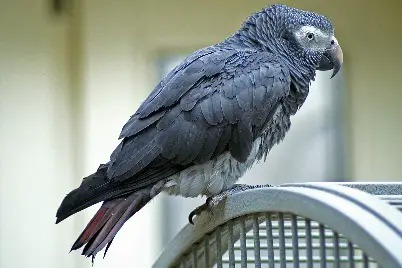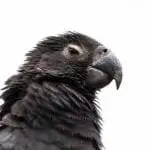Scientific Facts
| Common Name | Timneh Parrot |
| Scientific Name | Psittacus timneh |
| Lifespan | 50 – 60 Years |
| Size | 11.7 inches (30cm) |
| Body Mass | 11.2oz. (320grams) |
| Habitat | Rainforest, gallery forest, savanna, forest edges, clearings, cultivated land, mangroves |
| Range | West Africa |
Information & Physical Appearance
The Timneh Parrot (Psittacus timneh) is a member of the order Psittaciformes, the family Psittacidae, the tribe Psittacini, the genus Psittacus.
Other common names include Timneh Grey, Timneh Grey Parrot, and Timneh African Grey Parrot.
There are no recognized subspecies.
Timneh parrots are medium-sized birds. Both sexes are identical in physical appearance.
Adults’ plumage is mostly dark grey. There is a white face mask.
As compared with the Grey Parrot, the Timneh Parrot’s abdomen and rump are paler in color. In general, the Timneh parrot is darker in color and smaller in size than the Grey Parrot (P. erithacus).
The undertail coverts are tinged with dark red, while the main coloration is dark grey. The tail itself is dark maroon, and the feathers tails are edged with brown.
The lower mandible is black. The upper mandible is dark red and only tipped with black.
Juvenile
Juveniles’ physical appearance is quite identical to adults’.
However, the lower undertail coverts of immature Timneh parrots are grey tinged. Also, the tail is tipped with red.
Another difference is that juveniles’ eyes are dark grey to black in color, while adults’ eyes are pale yellow.
Lifespan

The Timneh parrot’s average lifespan is estimated at 50 – 60 years. There are recorded cases of Timneh African Grey Parrots having reached 80 years of age with proper care.
The generation length is 15.5 years.
Ecosystem & Habitat
RANGE
Psittacus timneh is a resident of West Africa.
Its native range spans across the western portions of the forests of Upper Guinea, reaching to the bordering savannas of West Africa.
Furthermore, it is found through Guinea and Guinea-Bissau in the east, Liberia, Sierra Leone, and Côte d’Ivoire’s Bandama River.
HABITAT
Timneh parrots are found in different types of habitats, namely secondary rainforest, primary rainforest, mangroves, clearings, forest edges, and savanna.
Also, they are found in cultivated land. Yet it remains unclear whether cultivated land, including gardens, does contain self-sustaining populations or not.
Food & Diet

Timneh parrots’ wild diet consists of various nuts, fruits, seeds, and berries. Oil palm fruits are gladly consumed, too.
Behavior

Timneh parrots are usually found in small flocks, consisting of up to a few dozen members in number. Although small-sized, these flocks can be quite noisy at times.
endangered
Reproduction
Timneh parrots may breed twice a year. Their breeding season takes place during the dry season.
They will breed from early January throughout February and/or from the beginning of June throughout July.
The clutch consists of 3 and up to 4 eggs. Incubation takes about 28 – 30 days. The young chicks are ready to fledge once they turn 11 – 12 weeks of age.
Survival Threats & Conservation
Timneh parrots are classified under the endangered category on the IUCN Red List of Threatened Species.
One of the major survival threats is none other but habitat loss related to modern-day residential and commercial development (urban areas and housing). The loss of habitat is estimated at up to 77% and has contributed to greatly decreasing the species’ natural range.
Wood harvesting and logging cause significant damage to these amazing wild creatures, too.
Tragically, the Timneh parrots found in Guinea-Bissau and Guinea have also been deprived of their preferred nest trees.
Another serious threat to the future survival of Timneh parrots in the wild is heavy trapping and hunting for the international exotic bird market.
Within a period of only 9 years (2005 – 2014), over 199 000 individuals have been exported.
While there is a systematic monitoring scheme, there is no action recovery plan in motion.
The population trend is decreasing. As of 2019, there are between 100 000 and up to 499 000 mature individuals left in the wild, according to the 2018 global assessment.
On the bright side, the population is not severely fragmented at this point. Also, conservation sites are identified over the entire range, and the species is subject to international trade controls, thanks to being listed on Appendix I of CITES.
Availability – Where to Get a Timneh Parrot

Timneh parrots are quite popular companion birds. They are also widely available.
You can acquire a Timneh parrot pet from various aviaries, aviary-specialty stores (both online and offline), directly from reputable breeders, and bird rescues.
Interesting Facts
1. Even though Timneh parrots are non-migratory birds, they may make seasonal movements in search of food. This typically happens during the dry season.
2. Timneh parrots have the emotional and mental capacity of a 5-year old human!
3. Timneh parrots are fully capable of amassing a vocabulary of up to 1000 words. Or even more!
What’s even more intriguing is that they do not only learn how to pronounce words but they can also use these words in context!
Praised for their extreme intelligence, they are given the moniker “The Einsteins of the Bird World.”
4. Timneh parrots are among the oldest psittacine species kept as pets by humans. There are existing records of Timneh parrots that date all the way back to biblical times.
How to Care for the Timneh Parrot
1. Housing & Accessories
Providing a spacious enclosure is a must.
A suspended cage or aviary will work great, as long as the minimum length is no smaller than 9.8ft. (3 meters).
Shallow water bowls or overhead misters are required for bathing purposes.
Include a variety of toys, such as non-toxic, destructible toys, non-destructible toys, foot toys, preening toys, and food-finder toys.
Also, provide hanging perch toys of varying texture and size.
Push-and-pull toys are highly recommended, too, and so are fir, willow, elder and/or pine branches.
Important Notes
Always introduce novelty items with care since some Timnehs tend to be sensitive to any new things introduced into their environment.
To prevent your Timneh from being affected by commotion and stress, it is best to position one corner of the cage right against a wall, instead of placing it in the very middle of a room.
2. Diet
About 70% of a healthy, balanced diet should consist of high-quality pelleted food. Complete kibble is a must.
About 30% of the captive diet should include daily servings of boiled corn, pears, pomegranate, apples, bananas, oranges, carrots, green beans, peas in the pod, as well as cooked pulses and beans, among other bird-safe fruits and vegetables.
Also, do offer dry, sprouted, or soaked sunflower seeds but only in moderation.
Rearing food includes carrots, wholegrain bread, and hard-boiled eggs.
3. Personality & Handling
Timneh African Grey Parrots are extremely intelligent.
They are known to form very strong bonds with their caregivers.
However, they can be quite emotionally needy. Because of this, prior to acquiring a Timneh parrot, owners-to-be need to consider very carefully whether they will be able to devote ample time to socializing and handling their feathery fellow on a daily basis.
Note that Timnehs also need a lot of exercises. Regular exercise helps to keep their muscles toned while also supporting the maintenance of adequate physical condition overall.
Timneh parrots should be able to spend several hours a day out of their cage. During their “free time” outside the cage, they have to be supervised.
To remain happy and healthy, these parrots require plenty of mental stimulation. Otherwise, they are prone to developing unpleasant habits and exhibiting destructive behavior.
Being the social creature that they are, Timneh parrots need a proper amount of hand-on time, yet they aren’t really into cuddling.
However, they can tolerate a bit of petting and some head-scratching, and in fact, some individuals may actually not mind a little bit of snuggling. Note that even if every single member of the family is to socialize with the Timneh pet from an early age, these parrots still have a tendency to become “one-person birds.”
4. Speech & Sounds
Timneh parrots are among the best talkers in the entire parrot family.
Timnehs are able to repeat both words and phrases as soon as they get to hear them just once or twice.The full talking ability takes place around one year of age, but many individuals actually become capable of mimicking speech at a much earlier point of their development.While Timneh Parrots may choose to talk rather than scream, they can be quite noisy at times.
5. Common Health Issues
Vitamin-A deficiency is quite common among Timneh parrots if they are fed inadequately. Veggies rich in beta-carotene should be provided on a regular basis, including but not limited to carrots, fresh kale and cooked sweet potatoes.
Vitamin-D deficiency can also become a concern, but it can be avoided by feeding a high-quality pelleted diet.
Other possible health issues include PBFD (psittacine beak and feather disease), respiratory infections (usually due to drafts), and psittacosis.
FAQ Section
How Long Do Timneh Parrots Live?
Most Timneh Parrots will live well into their 30s. When properly taken care of, they are fully capable of living to the rightful age of about 50 years, or even more.
Are Timneh African Grey Parrots Good Pets?
Timneh African Grey Parrots can be great pets for the right owners, as they are extremely intelligent and very affectionate. However, they do require high maintenance, so potential owners should make sure to provide a substantial, scheduled amount of time for socialization and one-on-one interaction.
What Is the Difference between Congo African Greys and Timneh Parrots?
The Congo African Grey Parrots’ plumage ranges from light to dark grey, while the Timneh African Grey Parrots’ plumage is dark-charcoal grey. Also, Congo African Grey Parrots are larger in size as compared with Timneh Parrots.
Should I Cover my Timneh Parrot at Night?
Sleep is vital to Timneh’s parrots, so they should be kept in a quiet, dark, semi-secluded area. Most will do just fine without being covered at night, but if the aviary/cage is not placed in a suitable, secluded, undisturbed area, the cage should better be covered at night.
How Much Do Timneh Parrots Cost?
Timneh parrots cost about $1000 – $1500 on average.
Do Timneh Parrots Bite?
There are many reasons why Timneh parrots may attempt to bite, and biting doesn’t necessarily equal aggressive behavior. It is the owner’s responsibility to study the Timneh African Grey Parrot’s body language to avoid getting bitten, as well as to teach the bird what is acceptable, appropriate behavior over time with patience and dedication.
How Smart Are Timneh Parrots?
Timneh Parrots have the reputation of some of the most intelligent birds in the world. They are extremely smart and emotional and are praised for their human-like ability to mimic speech.
How Long Can Timneh African Grey Parrots Go without Food?
Timneh African Grey Parrots can go for about 1 – 4 days without food, yet they will barely make it for more than 2 days without water. Do not leave your Timneh African Grey Parrot without food, as even if it does not die from starvation, the associated stress can still have an extremely adverse impact o its physical and mental health.
At What Age Do Timneh Parrots Start Talking?
Timneh parrots usually start talking between 12 – 19 months of age. However, it is best to start teaching your Timneh how to speak as early as possible, so don’t wait until it turns at least 12 months, and do mind that real chattering will typically begin later on overtime.
What Foods Are Bad for African Grey Parrots?
Do not feed your Timneh African Grey Parrot with chocolate, onion, garlic, comfrey, avocado, apple seeds, fruit pits, sugar-free candy, high-sugar foods, high-fat foods, high-sodium foods, and/or peanuts.
Are Timneh Parrots Endangered? Yes, Timneh Parrots (Psittacus timneh) are seriously threatened with extinction and are therefore listed under the Endangered category on the IUCN Red List. The population is currently under decline due to habitat loss and trapping these parrots for the wild bird trade.



